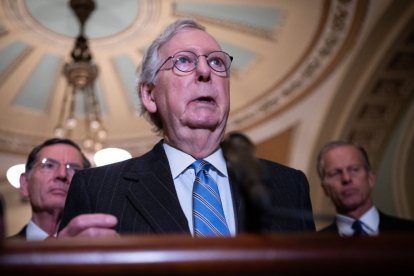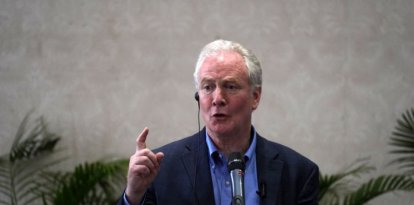Mitch McConnell and his legacy in the Senate: chief architect of the conservative majority on the Supreme Court from
The longest-serving leader in the history of the Senate announced Wednesday that he would step aside in November, ending his 17-year run as Senate Republican leader.

Graeme Sloan/Sipa USA / Cordon Press
Mitch McConnell surprised Washington, D.C., on Wednesday afternoon when he asked to speak in the Senate and announced that he would leave his position as leader of the Republicans at the end of the year. The senator from Kentucky, who happens to be the longest-serving leader in the history of the Senate, was moved at the end of his speech and assured that "one of life's most underappreciated talents is to know when it's time to move on to life's next chapter."
The Republican arrived in the Senate in 1985 after winning a historic election and defeating incumbent Walter Dee Huddleston by a margin of 5,000 votes out of more than 1.2 million cast. Since then, he achieved 7 re-elections, saw the same number of presidents pass through the Oval Office and was instrumental in advancing Republican agendas on Capitol Hill. However, perhaps his legacy can be seen more clearly in the judiciary branch.
Robert Bork and an obsession with the Supreme Court
The then-young senator quickly discovered what his cause would be in the Senate, and he did it almost without wanting to. In July 1987, President Ronald Reagan nominated Judge Robert Bork to the Supreme Court, hoping to fill the void left by Lewis F. Powell Jr., he would leave with his resignation.
However, he encountered fierce opposition from the Democrats, who at that time had a majority in the Upper House, opposition that was accompanied by a series of attacks of all kinds towards Bork, until then never seen in a hearing of this type. The hostility was such that even the judge's surname was inaugurated as a verb years later. According to Oxford Languages, it is "to obstruct (someone, especially a candidate for public office) by systematically defaming or vilifying them."
The treatment of Reagan's nominee surprised and motivated McConnell, who at the time did not have much power in the conference, to achieve a conservative court for years to come. He even made it clear to his colleagues that they had inaugurated a new way of evaluating a judicial nominee.
"And so to Robert Bork, you happen to be the one who set the new Senate standard that will be applied in my judgment by a majority of the Senate prospectively. Unfortunately, it got set over your dead body, so to speak, politically. We're going to do it when we want to, and when we want to is going to be when the president whoever he may be sends up somebody we don't like," he expressed at the time.
The pillars of a new court: Gorsuch, Kavanaugh and Coney Barrett
McConnell quickly found an ally in The Federalist Society. This new conservative think tank shared his interest in judicial nominees and would become instrumental. There is even talk that the organization is the filter for all judicial nominees of Republican presidents, with a preference for originalists and textualists.
The senator saw his party successfully advance the nominations of Clarence Thomas in 1991, John Roberts in 2005 and Samuel Alito in 2006. He managed to rise to the party's leadership in 2007 when he replaced Bill Frist as Leader of the Senate Republican Conference, a position he holds to this day.
His first litmus test came at the beginning of 2016, and coincidentally, it would be the most remembered episode of his time as leader. Overnight, McConnell was faced with the death of Supreme Court Justice Antonin Scalia, whose seat on the nation's highest court now had to be replaced. The problem was that the president was a Democrat, at that time, Barack Obama, who lived with a Republican Senate, so from the beginning, there were doubts about how the matter would proceed.
McConnell did not let a day pass to clear up those doubts and stated hours later that he would not allow the consideration of any judge under the Democrat's mandate since the election for a lifetime position should be the next president. The case generated a lot of controversy at the time and led to a negotiation between Donald Trump, McConnell, and the Federalist Society to announce a list of possible nominees under an eventual Trump Administration. In the eyes of Steve Bannon, "Trump would not have been president without that list."
Trump eventually won the election and nominated Neil Gorsuch, who the Senate would later confirm.
McConnell kept the promise he had made to Harry Reid (D-NV) and used the nuclear option to change the rules of the Senate and lower the threshold for confirming judges to the Supreme Court, which went to a simple majority of 50+ 1 . Years ago, the Democrats had done the same for federal judges, which had aroused the anger of the Republican leader, who took advantage of the opportunity to take revenge.
Gorusch was followed by the stormy chapter of Brett Kavanaugh, another litmus test for the majority leader, who, in this case, had to struggle to unite the conference behind the name.
The nominee was accused of sexual abuse by Dr. Christine Blasey Ford, who even testified in front of the Senate Judiciary Committee. Although his testimony mobilized several senators, the majority of Republicans found the case to be a political move to discredit Trump's then-nominee.
"Democrats wouldn't let a few inconvenient things get between them and a good smear. It's despicable," McConnell said at the time. The Senate would later confirm Kavanaugh, marking a second victory for the Kentucky senator, who now saw a court with a 5-4 conservative majority. However, a victory was still missing to consecrate what analysts consider to be his legacy.
"We live in the air of the McConnell Court"
The final touch during the Trump Administration came months after the Republican ended his term. In a similar but opposite situation to that of 2016, Judge Ruth Bader Ginsburg's death generated an unexpected vacuum from the most progressive side of the highest court.
McConnell had two options: repeat the speech he used years ago or take advantage of the opportunity he had waited for his entire career to establish a conservative majority on the Supreme Court. Despite criticism from some colleagues, the senator moved as quickly as possible with the nomination of Amy Coney Barrett, who was barely confirmed, 52-48, weeks before the presidential election.
"He did it because he could do it," Ted Olson, former attorney general during part of George W. Bush's administration, later expressed.
Barrett was sworn in at the White House in the presence of McConnell, who, 33 years after frustration with Judge Bork's case, ended up being the chief architect of a solid conservative majority on the Supreme Court, which he has since reversed. Roe vs. Wade, Planned Parenthood v. Casey, and eliminated positive discrimination in universities.
One of the most concrete summaries of the Republican's legacy came from the mouth of journalist Ed O'Keefe, who stated the following in a documentary: "You can talk about the Warren Court or the Roberts Court... We now live in the air of the McConnell Court. And it very well could be the McConnell Court for several decades to come".
RECOMMENDATION





















